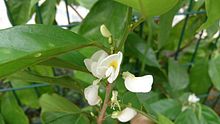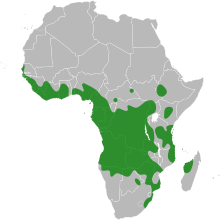Baphia is a small genus of legumes that bear simple leaves.[3] Baphia is from the Greek word βάπτω (báptō-, "to dip" or "to dye"), referring to a red dye that is extracted from the heartwood of tropical species.[3][4] The genus is restricted to the African tropics. Baphia was traditionally assigned to the tribe Sophoreae;[5] however, recent molecular phylogenetic analyses reassigned Baphia to the tribe Baphieae.[6][7][8][9]
| Baphia | |
|---|---|

| |
| Baphia nitida | |
| Scientific classification | |
| Kingdom: | Plantae |
| Clade: | Tracheophytes |
| Clade: | Angiosperms |
| Clade: | Eudicots |
| Clade: | Rosids |
| Order: | Fabales |
| Family: | Fabaceae |
| Subfamily: | Faboideae |
| Clade: | Meso-Papilionoideae |
| Tribe: | Baphieae |
| Genus: | Baphia Afzel. ex G.Lodd. (1820) |
| Species | |
|
See text | |

| |
| Range of the genus Baphia.[1] | |
| Synonyms[2] | |
| |
Species
editBaphia comprises the following species:[1][10][11][12]
Section Alata M.O.Soladoye
edit- Baphia cordifolia Harms
Section Baphia Lodd.
editSeries Baphia Lodd.
edit- Baphia abyssinica Brummitt
- Baphia dewevrei De Wild.
- Baphia dewildeana M.O.Soladoye
- Baphia latiloi M.O.Soladoye
- Baphia laurifolia Baillon
- Baphia longipedicellata De Wild.
- subsp. keniensis (Brummitt) M.O.Soladoye
- subsp. longipedicellata De Wild.
- Baphia mambillensis M.O.Soladoye
- Baphia marceliana De Wild.
- subsp. marceliana De Wild.
- subsp. marquesii (M.Exell) M.O.Soladoye
- Baphia nitida Lodd. (Camwood)
- Baphia pauloi Brummitt
- Baphia pubescens Hook.f.
- Baphia puguensis Brummitt
- Baphia punctulata Harms
- subsp. descampsii (De Wild.) M.O.Soladoye
- subsp. palmensis M.O.Soladoye
- subsp. punctulata Harms
Series Contiguinae M.O.Soladoye
edit- Baphia angolensis Baker
- Baphia brachybotrys Harms
- Baphia breteleriana M.O.Soladoye
- Baphia buettneri Harms
- subsp. buettneri Harms
- subsp. hylophila (Harms) M.O.Soladoye
- Baphia gossweileri Baker f.
- Baphia incerta De Wild.
- subsp. incerta De Wild.
- subsp. lebrunii (L.Touss.) M.O.Soladoye
- Baphia leptostemma Baillon
- subsp. gracilipes (Harms) M.O.Soladoye
- var. gracilipes (Harms) M.O.Soladoye
- var. conraui (Harms) M.O.Soladoye
- subsp. leptostemma Baillon
- subsp. gracilipes (Harms) M.O.Soladoye
- Baphia preussii Harms
- Baphia obanensis Baker f.
- Baphia wollastonii Baker f.
Series Spathaceae M.O.Soladoye
edit- Baphia eriocalyx Harms
- Baphia spathacea Hook.f.
- subsp. polyantha (Harms) M.O.Soladoye
- subsp. spathacea Hook.f.
Section Bracteolaria (Hochst.) Benth.
edit- Baphia aurivellera Taubert
- Baphia capparidifolia Baker
- subsp. bangweolensis (R.E.Fries) Brummitt
- subsp. capparidifolia Baker
- subsp. multiflora (Harms) Brummitt
- subsp. polygalacea Brummitt
- Baphia dubia De Wild.
- Baphia heudelotiana Baillon
- Baphia kirkii Baker
- subsp. kirkii Baker
- subsp. ovata (Sim) M.O.Soladoye
- Baphia laurentii De Wild.
Section Longibracteolatae (Lester-Garland) M.O.Soladoye
editSeries Chrysophyllae M.O.Soladoye
edit- Baphia burttii Baker f.
- Baphia chrysophylla Taubert
- subsp. chrysophylla Taubert
- subsp. claessensii (De Wild.) Brummitt
- Baphia cuspidata Taubert
- Baphia massaiensis Taubert
- subsp. busseana (Harms) M.O.Soladoye
- subsp. floribunda Brummitt
- subsp. gomesii (Baker f.) Brummitt
- subsp. massaiensis Taubert
- subsp. obovata (Schinz) Brummitt
- var. cornifolia (Harms) M.O.Soladoye
- var. obovata (Schinz) M.O.Soladoye
- var. whitei (Brummitt) M.O.Soladoye
- Baphia speciosa J.B.Gillett & Brummitt
Series Macranthae M.O.Soladoye
edit- Baphia bequaertii De Wild.
- Baphia letestui Pellegrin
- Baphia maxima Baker
Series Striatae (Lester Garland) M.O.Soladoye
edit- Baphia leptobotrys Harms
- subsp. leptobotrys Harms
- subsp. silvatica (Harms) M.O.Soladoye
- Baphia pilosa Baillon
- subsp. batangensis (Harms) M.O.Soladoye
- subsp. pilosa Baillon
Section Macrobaphia Harms emend. M.O.Soladoye
edit- Baphia bergeri De Wild.
- Baphia macrocalyx Harms
- Baphia semseiana Brummitt
Incertae sedis
edit- Baphia cymosa Breteler
- Baphia madagascariensis (A.Heller) A.Heller
Species names with uncertain taxonomic status
editThe status of the following species is unresolved:[12]
- Baphia glauca A. Chev.
- Baphia longepetiolata Taub.
- Baphia madagascariensis C.H. Stirt. & Du Puy
- Baphia megaphylla Breteler
- Baphia radcliffei Baker f.
In 2023, a new species, Baphia arenicola was discovered growing in the deep sandy highland region of central Angola, part of the Kalahari sands, and was formally described to science. The floral characters most morphologically similar to Baphia massaiensis but with certain characters also comparable to Baphia bequaertii, with all three species found growing in the same region. Preliminary molecular analysis places the new taxon close to Baphia bequaertii. Whilst most Baphia form above ground shrubs and trees, Baphia arenicola grows as a geoxylic suffrutex (often described as "underground trees") with most of its woody tissue growing buried deep within the sand and its flowering parts just above ground level.[13][14]
References
edit- ^ a b Soladoye MO (1985). "A revision of Baphia (Leguminosae-Papilionoideae)". Kew Bulletin. 40 (2): 291–386. Bibcode:1985KewBu..40..291S. doi:10.2307/4108263. JSTOR 4108263.
- ^ Baphia Afzel. ex G.Lodd. Plants of the World Online. Retrieved 12 August 2023.
- ^ a b Pooley E. (1997). Trees of Natal, Zululand and Transkei. Durban: Natal Flora Publications Trust. p. 160. ISBN 978-0-620-17697-2.
- ^ "Baphia". Legumes of the World. Kew Royal Botanic Gardens. Retrieved November 3, 2016.
- ^ Polhill RM (1981). "Sophoreae". In Polhill RM, Raven PH (eds.). Advances in Legume Systematics, Part 1. Royal Botanic Gardens, Kew. pp. 213–230. ISBN 9780855212247. Archived from the original on 2013-12-03. Retrieved 2016-11-03.
- ^ Cardoso D, Pennington RT, de Queiroz LP, Boatwright JS, Van Wyk B-E, Wojciechowski MF, Lavin M (2013). "Reconstructing the deep-branching relationships of the papilionoid legumes". S Afr J Bot. 89: 58–75. doi:10.1016/j.sajb.2013.05.001. hdl:10566/3193.
- ^ Pennington RT, Lavin M, Ireland H, Klitgaard B, Preston J, Hu J-M (2001). "Phylogenetic relationships of basal papilionoid legumes based upon sequences of the chloroplast trnL intron". Syst Bot. 55 (5): 818–836. doi:10.1043/0363-6445-26.3.537 (inactive 1 November 2024).
{{cite journal}}: CS1 maint: DOI inactive as of November 2024 (link) - ^ Wojciechowski MF, Lavin M, Sanderson MJ (2004). "A phylogeny of legumes (Leguminosae) based on analysis of the plastid matK gene resolves many well-supported subclades within the family". Am J Bot. 91 (11): 1846–862. doi:10.3732/ajb.91.11.1846. PMID 21652332.
- ^ Cardoso D, de Queiroz LP, Pennington RT, de Lima HC, Fonty É, Wojciechowski MF, Lavin M (2012). "Revisiting the phylogeny of papilionoid legumes: New insights from comprehensively sampled early-branching lineages". Am J Bot. 99 (12): 1991–2013. doi:10.3732/ajb.1200380. PMID 23221500.
- ^ "ILDIS LegumeWeb entry for Baphia". International Legume Database & Information Service. Cardiff School of Computer Science & Informatics. Retrieved 3 November 2016.
- ^ USDA; ARS; National Genetic Resources Program. "GRIN species records of Baphia". Germplasm Resources Information Network—(GRIN) [Online Database]. National Germplasm Resources Laboratory, Beltsville, Maryland. Retrieved 3 November 2016.
- ^ a b "The Plant List entry for Baphia". The Plant List. Royal Botanic Gardens, Kew and the Missouri Botanical Garden. 2013. Retrieved 3 November 2016.
- ^ Goyder, David J.; Davies, Nina; Finckh, Manfred; Gomes, Amândio; Gonçalves, Francisco Maiato P.; Meller, Paulina; Paton, Alan J. (2023-09-20). "New species of Asclepias (Apocynaceae), Baphia (Leguminosae), Cochlospermum (Bixaceae) and Endostemon (Lamiaceae) from the Kalahari sands of Angola and NW Zambia, with one new combination in Vangueria (Rubiaceae)". PhytoKeys (232): 145–166. doi:10.3897/phytokeys.232.110110. ISSN 1314-2003. PMC 10534249. PMID 37780180.
- ^ "Top 10 plant and fungal species named new to science in 2023 | Kew". www.kew.org. Retrieved 2024-09-06.
- Data related to Baphia at Wikispecies